The Biology of Ephraim (UK) versus Manasseh (USA)
Physical Differences.
Ephraim versus Manasseh in Biology?
1. Introduction. Manasseh and Ephraim within the British Isles
2. Celtic Versus English Feet. Anecdote
3. DNA
4. Extracts from Popular Sources.
A. Feet Shapes
B. DNA Sources
5. More Maps of Interest.
====================
1. Introduction.
Manasseh and Ephraim within the British Isles
The USA is Manasseh, the UK and its British Dominions represent Ephraim.
We have proven this from Biblical, Rabbinical, and Historical Sources.
In short we have shown how the early colonists from the British isles came from DIFFERENT parts than those who remained dominant. Most of the colonists came from the "Celtic-dominated" west and north whereas the dominant forces in Britain remained in the "English" areas east and south. Even when the colonists also came from the "English" areas they had mostly emerged from social classes that were different from the mainstream.
See:
Historical Social Differences. Ephraim (UK) versus Manasseh (USA)
http://hebrewnations.com/articles/tribes/socialjoseph.html
We find PHYSICAL DIFFERENCES in Britain between the two areas. To illustrate these we have chosen to speak of the Comparative Shapes of Feet and of DNA.
====================
2. Celtic Versus English Feet.
English feet tend to be more of a square shape than Celtic feet. Shoes made for English people may not be suitable for those from "Celtic " areas more to the west where the feet are longer and thinner.
Anecdote
An acquaintance served in the Australian Army in the late 1960s. The inductees were issued boots made in England. Initial training entailed marching drills,long marches, hikes, and running. He suffered severely from blisters that occasionally left him incapacitated. Later the boots were replaced with American issue of a different type. The problems with his feet ceased. It now seems that the problem had been caused by English boots having been designed for English people from the east and south of England. His feet however however were more of a Celtic type such as those found more in the west and north and in Ireland.

====================
3. DNA
We understand that DNA is ultimately determined by Environment. Nevertheless, for long periods of time the same DNA types are transmitted by hereditary. This enables to determine physical relationships between individuals and also whole between one group of people and another.
The early inhabitants of Britain spoke a Celtic type languages and shared a Celtic type culture. Those in the north and west were different from those in the "Belgae" area south and east. The Belgae also inhabited an area of Gaul including what is now part of north east France, Belgium and the west Netherlands. To a degree they overlapped with peoples known as the Galatea. The Angles, Saxons, Jutes, and other conquered what later became "England." They became especially prominent in former "Belgae" areas. Nevertheless they still remained a minority in those regions. 40% of the English in general have "Belgae" (sometimes referred to as "French") DNA which is especially strong in Belgae areas within Britain! Anglo-Saxon DNA (similar to that of West Germany) is also strong in those regions but accounts for only 20%. In the rest of the British Isles Celtic DNA is predominant with an overlaying of Anglo-Saxon. The "Belgae" areas today and in the past have often been the most imprtant. The "Belgae" (45%) are referred to as "French" in Map 1 below. The Anglo-Saxons (25%) are called "German."
Map 1.
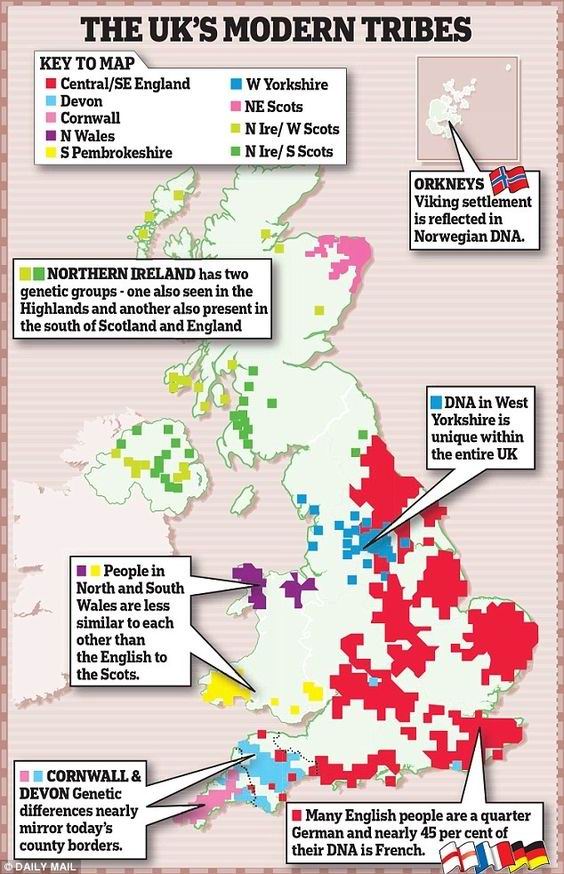
In Map 2 below the "Belgae" appear to be called "Frisian."
Map 2.

in Map 3 (i.e. illustration) the Belgae appear to be referred to as "Great Britain" (Anglo-Saxon) whereas those referred to as 'European" are the "Anglo-Saxons" of Histroy. Confusing is it not?
Map 3.
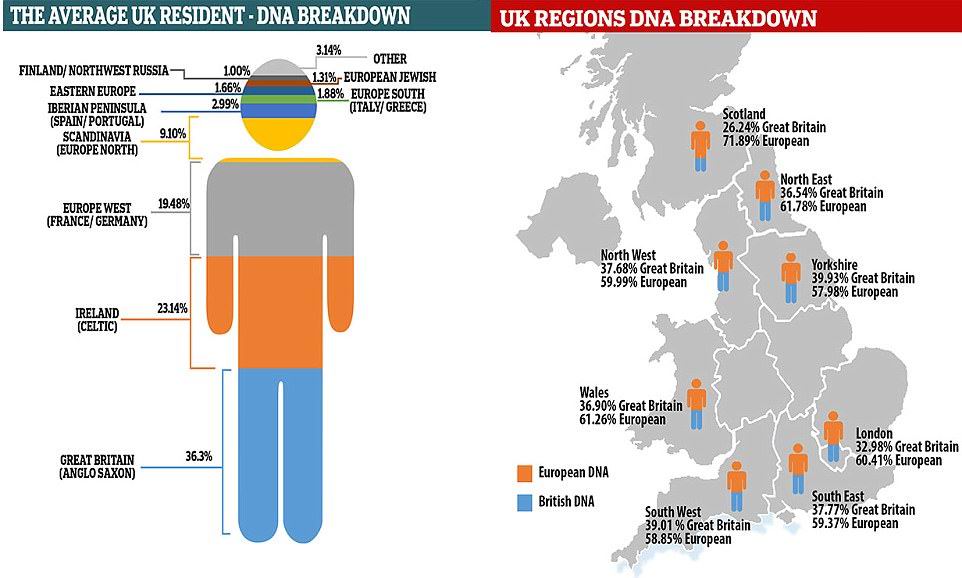
^^^^^^^^^^^^^^^^^^^^^^^
4. Extracts from Popular Sources.
====================
A. Feet Shapes
British Feet
http://discovermagazine.com/1996/jun/britishfeet799
June 1996 issue of "Discover."
The Germanic tribes of Angles and Saxons who invaded Britain in the fifth and sixth centuries A.D. left a significant legacy. Their language evolved into modern English, largely replacing indigenous Celtic tongues. Some of their laws formed the basis of English common law. And their feet, it would now appear, formed the basis of modern Englishmen.
Or so says Phyllis Jackson, a retired Gloucestershire podiatrist. Jackson got her first inkling of a distinctively Saxon foot during World War II, when Hereford, the small city in western England where she then lived, was flooded with refugees from more significant cities (which were being bombed by latter-day Germans). Some of these evacuees became Jackson's patients, and some of them turned out to be of Celtic descent-- Scottish, Irish, Welsh, and Cornish. Poor things were coming to me with awful bunions, recalls Jackson. I realized that the foot shape I was dealing with was quite different from the English one I was accustomed to.
Traditional English feet, Jackson says, tend to be broad and somewhat pointed--the toes form a steep angle from the first to the fifth. The Celtic evacuees, in contrast, had toe tips that were almost level with one another, and their feet tended to be longer and slimmer--except for a bulge at the base of the big toe, where bunions form. The English shoe being modeled on the English foot, many of Jackson's new patients couldn't cram their feet into that shape of shoe. Hence they developed the bunions.
After retiring from podiatry, Jackson took up amateur archeology but kept her focus on feet. Examining the skeletal remains of a few dozen Saxons and Celts from a sixth-century cemetery in Lechlade, Gloucestershire, she found she could readily tell them apart. It wasn't just that the Saxons were the ones buried with bronze brooches and amber necklaces--they also had feet shaped like modern English feet. Jackson also found a distinctive feature in the cuboid bone, just beneath the fourth and fifth toes: it was slightly scrunched on one side in Saxon feet, but more square in Celts.
Aside from stimulating people of British descent to take a closer look at their extremities, Jackson's research--which has not been subjected to formal peer review--may help British archeologists. They have traditionally relied on burial artifacts to distinguish Celtic from Saxon skeletons, thus glossing over the likelihood that some Celts adopted Saxon ways. What she is offering is a possibility of being able to sort out the immigrant from the indigenous population, says archeologist Barry Cunliffe of Oxford. She needs a bigger sample, but she's spotted differences that are very real and very well worth following up.
See Also:
Discovering ancestry: Through our toes?
 By EstherÂ
https://blog.myheritage.com/2014/09/discovering-ancestry-through-our-toes/
====================
B. DNA Sources.Â
DNA of the nation revealed...and we're not as 'British' as we think
https://www.ancestry.com/corporate/international/press-releases/DNA-of-the-nation-revealedand-were-not-as-British-as-we-thinkÂ
Extracts:
... the average UK resident is 36.94% British (Anglo Saxon), 21.59% Irish (Celtic) and 19.91% Western European (the region covered today by France and Germany).
Following these top three regional ethnicities in the average UK resident are Scandinavia (9.20%), the Iberian Peninsula (Spain/Portugal) (3.05%), and Italy and Greece (1.98%).
Interestingly, breakdowns of the data also reveal differences between residents of England, Scotland, Wales, Northern Ireland, and even within English regions.
English people have significantly less Irish ancestry (just 20% of their genetic make-up) on average compared to people living in Scotland (43.84%), Wales (31.99%) and Northern Ireland (48.49%). English residents do however have the highest amount of Scandinavian (9.39%) and Western European (French/German) (20.45%) ancestry. Â
French DNA Map
Source:
https://www.dailymail.co.uk/sciencetech/article-3000998/Are-Welsh-truest-Brits-English-genomes-contain-German-French-DNA-Romans-left-no-trace.htmlÂ
'We do not have good evidence for this from the material culture but Caesar refers to the settlement of Belgae in this area of Britain in the mid-1st century BC,' Prof Robinson added.
'These were a people who inhabited an area of Gaul including what is now part of north east France, Belgium and the west Netherlands. A completely unknown migration is also a possibility.'
Quoi?! British DNA is 40% French, Oxford study finds
https://www.rt.com/uk/242157-uk-dna-genetic-study/Â
The People of the British Isles Study was carried out by scientists from the University of Oxford's Wellcome Trust Centre for Human Genetics using DNA from over 2,000 rural people, whose four grandparents were born within 80 kilometers of each other in the late 1800s.
One of its most striking findings was that white Britons today share 40 percent of their DNA with the French and 30 percent with modern Germans.....
Cornish people, the study adds, are much more closely related to the English than the Celts.
The genetic impact of Norman, Viking and Roman invaders was found to be negligible. Even today many British people are still located within the borders of ancient kingdoms from which they are descended.
The long standing claim by the Welsh that they are the most original Brits was also vindicated in the study, which found they are the most closely related to the original Stone Age hunter gatherers, who settled in Britain following the last Ice Age.
The Welsh were the least affected by a large wave of pre-Roman European settlement by Angles in the east, south and center of Britain.
====================
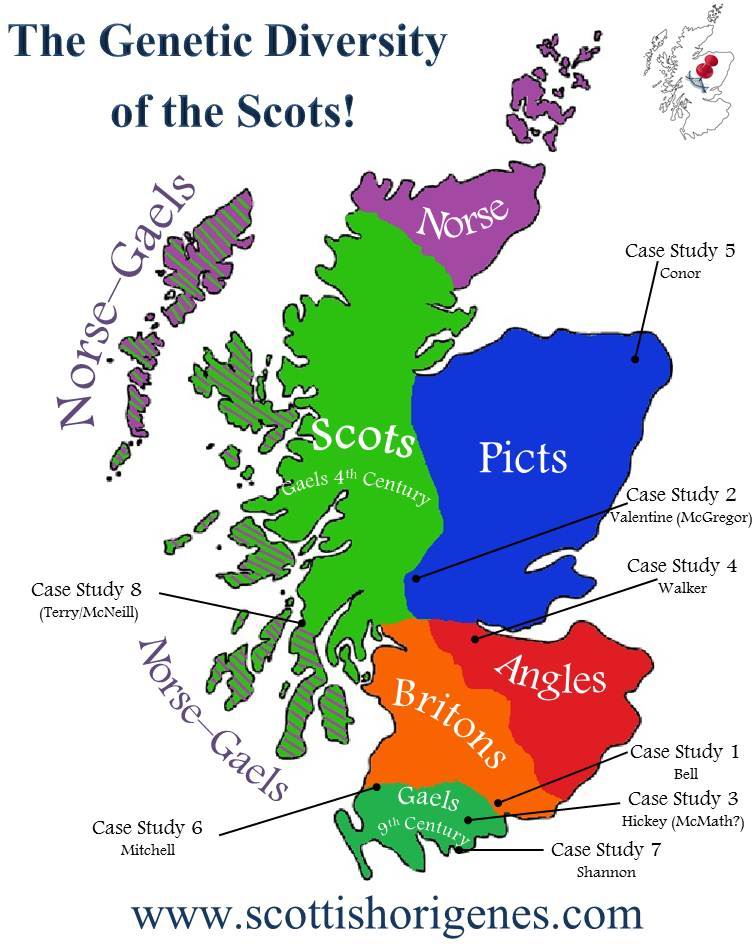
Â
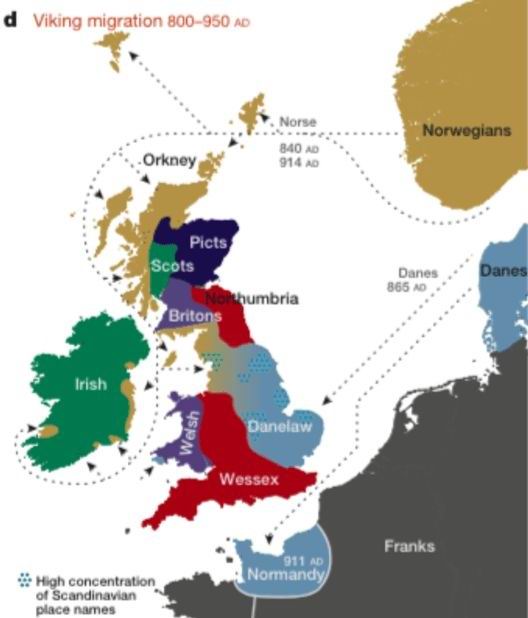
Â
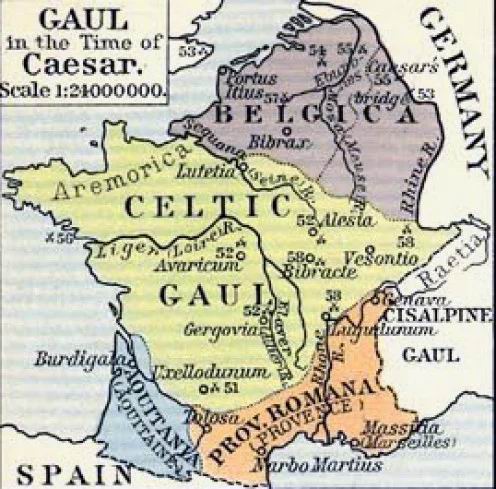
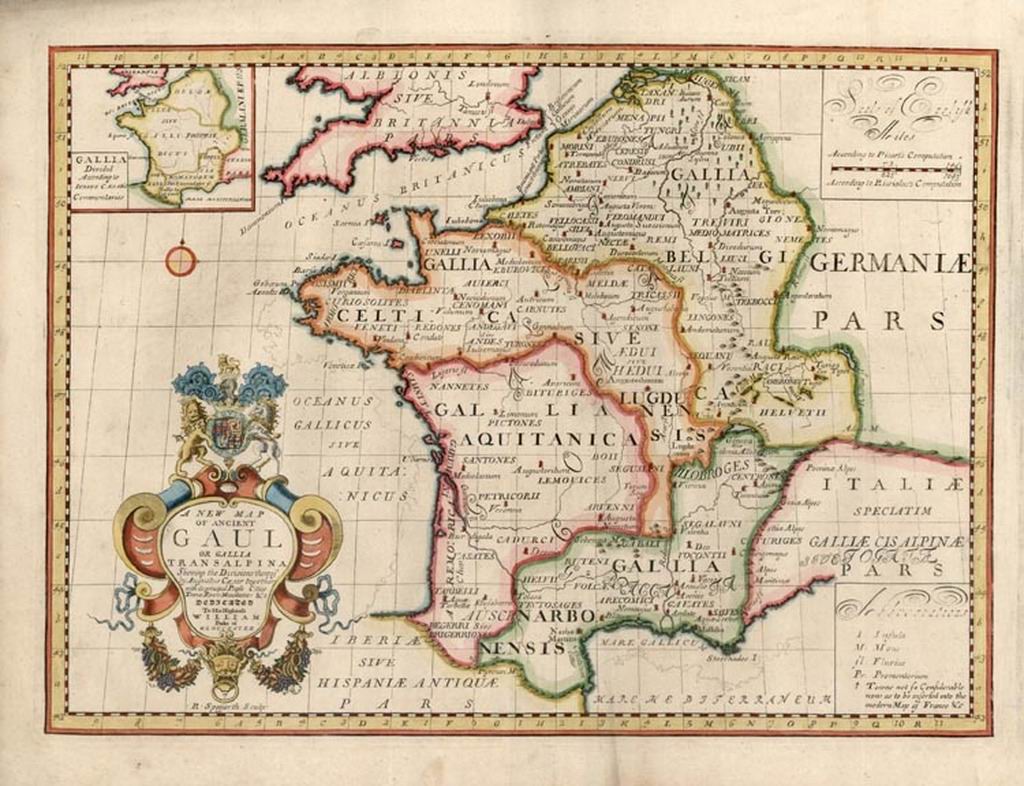
Â
